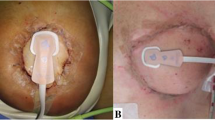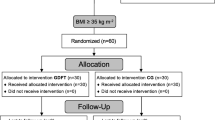Abstract
Objective
To compare subcutaneous (PscO2) and transcutaneous (PtcO2) oxygen tension measurements in relation to hemodynamic variables at different levels of PEEP, and to evaluate the usefulness of these measurements as monitors of peripheral tissue perfusion.
Design
Prospective trial.
Setting
Intensive care unit in a university hospital.
Patients
Seven patients with gastric cancer who where undergoing total gastrectomy.
Interventions
Silicone catheter was placed in the upper arm and transcutaneous oxygen monitor was placed on the upper part of the chest. A pulmonary artery catheter was placed in the right pulmonary artery.
Measurements and results
PscO2 and PtcO2 together with hemodynamic variables were measured at different levels of PEEP. Progressive increase of PEEP reduced cardiac index (CI) (p<0.05) with a concomitant decrease of PscO2 (p<0.05) and oxygen delivery (DO2) (p<0.05). Changes in PtcO2 parallelled changes in arterial oxygen tension (PaO2), but no correlation was found between PtcO2, CI and DO2.
Conclusion
PscO2 is a sensitive indicator of subcutaneous tissue perfusion, which can be used to identify the PEEP level, with optimum peripheral perfusion. PscO2 seems to be a more reliable indicafor of tissue perfusion than PtcO2.
Similar content being viewed by others

References
Jönsson K, Jensen JA, Goodson III WH, West JM, Hunt TK (1987) Assessment of perfusion in postoperative patients using tissue oxygen measurements. Br J Surg 74:263–267
Fujimoto D, Tamiya N (1962) Incorporation of18O from air into hydroxyproline by chick embryo. Biochem J 84:333–335
Prockop D, Kaplan A, Udenfried S (1963) Oxygen-18 studies on the conversion of proline to collagen hydroxyproline. Arch Biochem Biophys 101:499–503
Hunt TK, Zederfeldt BH, Goldstick TK, Conolly WB (1967) Tissue oxygen tension during controlled hemorrhage. Surg Forum 18:3–4
Hunt TK, Niinikoski J, Zederfeldt BH, Silver IA (1977) Oxygen in wound healing enhancement: Cellular effects of oxygen. In: Davis JC, Hunt TK (eds) Hyperbaric oxygen therapy. Undersea Medical Society Inc. Bethesda, Maryland, pp 111–122
Niinikoski J, Hunt TK, Dunphy JE (1972) Oxygen supply in healing tissue. Am J Surg 123:247–252
Stephens FO, Hunt TK (1971) Effects of changes in inspired oxygen and carbon dioxid tensions on wound tensile strength. Ann Surg 173:515–519
Hartmann M, Jönsson K, Zederfeldt BH (1972) Importance of dehydration for anastomotic and subcutaneous wound healing. An experimental study in rats. Eur J Surg 158:79–82
Shoemaker WC, Montgomery ES, Kaplan E, Elwyn DH (1973) Physiologic patterns in surviving and nonsurviving shock patients. Arch Surg 106:630–636
Waxman K, Lazrove S, Shoemaker WC (1981) Physiologic responses to operation in high risk surgical patients. Surg Gynecol Obstet 152:633–638
Tremper KK, Waxman K, Shoemaker WC (1981) Use of transcutaneous oxygen sensors to titrate PEEP. Ann Surg 193:206–209
Tremper KK, Waxman K, Bowman R, Shoemaker WC (1980) Continuous transcutaneous oxygen monitoring respiratory failure, cardiac decompensation, cardiac arrest, and CPR. Crit Care Med 8:377–381
Tremper KK, Shoemaker WC (1981) Transcutaneous oxygen monitoring of critically ill adults, with and without low flow shock. Crit Care Med 9:706–709
Tremper KK, Waxman K, Shoemaker WC (1979) Effects-of hypoxia and shock on transcutaneous PO2 values in dogs. Crit Care Med 7:526–531
Rowe MI, Weinberg G (1979) Transcutaneous oxygen monitoring in shock and resuscitation. J Pediatr Surg 14:773–778
Waxman K, Sadler R, Eisner ME, Applebaum BS et al (1983) Transcutaneous oxygen monitoring of emergency department patients. Am J Surg 146:35–38
Littooy F, Fuchs R, Hunt TK, Sheldon GF (1976) Tissue oxygen as a real-time measure of oxygen transport. J Surg Res 20:321–325
Nolan LS, Shoemaker WC (1982) Transcutaneous O2 and CO2 monitoring of high risk surgical patients during the perioperative period. Crit Care Med 10:762–764
Fink S, Ray CW, McCartney S, Ehrlich H et al (1984) Oxygen transport and utilization in hyperoxia and hypoxia: Relation of conjunctival and transcutaneous oxygen tensions to hemodynamic and oxygen transport variables. Crit Care Med 12:943–948
Shoemaker WC, Fink S, Ray CW, McCartney S (1984) Effects of hemorrhagic shock on conjunctival and transcutaneous oxygen tensions in relation to hemodynamic and oxygen transport changes. Crit Care Med 12:949–952
Haldén E (1982) Monitoring of optimal oxygen transport by the transcutaneous oxygen tension method in the pig. Acta Anaesth Scand 26:209–212
Powers SR, Mannal R, Neclerio M, English M et al. (1973) Physiologic consequences of positive end-expiratory pressure (PEEP) ventilation. Ann Surg 178:265–272
Ashbaugh DG, Petty TL (1973) Positive end-expiratory pressure. J Thorac Cardiovasc Surg 65:165–170
Walkinshaw M, Shoemaker WC (1980) Use of volume loading to obtain preferred levels of PEEP. Crit Care Med 8:81–86
Gottrup F, Gellet S, Kirkegaard L, Hansen ES et al (1989) Effect of hemorrhage and resuscitation on subcutaneous, conjunctival, and transcutaneous oxygen tension in relation to hemodynamic variables. Crit Care Med 17:904–907
Shabot MM, Shoemaker WC (1977) Rapid bedside computation of cardiorespiratory variables with a programmable calculator. Crit Care Med 5:105–111
Gottrup F (1991) Tissue oxygen tension monitoring: Relation to hemodynamic and oxygen transport variables. In: Gutierrez G, Vincent JL (eds) Tissue oxygen utilizatior. Springer, Berlin Heidelberg New York, pp 322–336
Gottrup F, Firmin R, Chang N, Goodson III WH et al. (1983) Continuous direct tissue oxygen tension measurements by a new method using and implanted silastic tonometer and oxygen polarography. Am J Surg 146:399–403
Chang N, Goodson III WH, Gottrup F, Hunt TK (1983) Direct measurement of wound and tissue oxygen tension in postoperative patients. Ann Surg 197:470–478
Maxwel TM, Lim RC, Fuchs R, Hunt TK (1973) Continuous monitoring of tissue gas tensions and pH in hemorrhagic shock. Am J Surg 126:249–254
Gottrup F, Niinikoski J, Hunt TK: Measurement of tissue oxygen tension in wound repair. In: Janssen H, Rooman R, Robertson JIS (eds) Wound healing. Wrightson Biomedical Publishing, Blackwell, Oxford, pp 155–164
Dantzker DR (1988) Oxygen transport and utilization. Respir Care 33:874–880
Kram HB (1985) Noninvasive tissue oxygen monitoring in surgical and critical care medicine. Surg Clin North Am 65:1005–1025
Lübbers DW (1981) Theoretical basis of the transcutaneous blood gas measurments. Crit Care Med 9:721–733
Gottrup F, Firmin R, Rabkin J, Halliday BJ et al (1987) Directly measured tissue oxygen tension and arterial oxygen tension assess tissue perfusion. Crit Care Med 15:1030–1036
Hartmann M, Montgomery M, Jönsson K, Haglund U (1991) Tissue oxygenation in hemorrhagic shock measured as transcutaneous oxygen tension, subcutaneous oxygen tension, and gastrointestinal intramucosal pH in pigs. Crit Care Med 19:205–210
Nelimarkka O, Niinikoski J (1984) Oxygen and carbon dioxide tensions in the canine kidney during arterial occlusion and hemorrhagic hypotension. 158:27–32
Kivilaakso E, Ahonen J, Aronsen KF, Höckerstedt KAV et al (1982) Gasfric blood flow, tissue gas tension and microvascular changes during hemorrhage-induced stress ulceration in the pigs. Am J Surg 143:322–330
Korsbäck C, Nyman N, Scheinin T (1984) Small bowel and liver tissue PO2 and PCO2 during hypovolemic shock and intravenous vasopressin infusion. Ann Cir Gynecol 73:236–240
Mäkisalo HJ, Korsbäck CH, Soini HO, Heino A et al (1989) Correction of hemorrhagic shock-induced liver hypoxi with whole blood, Ringer's solution and with hetastarch. Res Exp Med 189:397–407
Mäkisalo HJ, Soini HO, Nordin AJ, Höckersted KAV (1989) Tissue oxygenation in predicting “irreversible” hemorrhagic shock. Surg Res Comm 5:175–184
Shoemaker WC (1981) Physiological and clinical significance of PtcO2 and PtcCO2 measurements. Crit Care Med 9:689–690
Gottrup F, Gellett S, Kirkegaard L, Hansen ES et al (1988) Continuous monitoring of tissue oxygen tension during hyperoxia and hypoxia: relation of subcutaneous, transcutaneous, and conjunctival oxygen tension to hemodynamic variables. Crit Care Med 16:1229–1234
Kirby RR, Perry JC, Calderwood HW, Ruiz BC et al (1975) Cardiorespiratory effects of high end-expiratory pressure. Anaesthesiology 43:533–539
Shibutani K, Komatzu T, Kubal K, Sanchala V et al (1983) Critical level of oxygen delivery in anesthetized man. Crit Care Med 11:640–643
Author information
Authors and Affiliations
Additional information
This study was supported by Tore Nilsons Fund for Medical Research. Lundgrens Stiftelse, Medical Faculty, University of Lund and by the Swedish Medical Research Council Projecr no. B88-17x-00640-24B
Rights and permissions
About this article
Cite this article
Hartmann, M., Rosberg, B. & Jönsson, K. The influence of different levels of PEEP on peripheral tissue perfusion measured by subcutaneous and transcutaneous oxygen tension. Intensive Care Med 18, 474–478 (1992). https://doi.org/10.1007/BF01708584
Received:
Accepted:
Issue Date:
DOI: https://doi.org/10.1007/BF01708584



